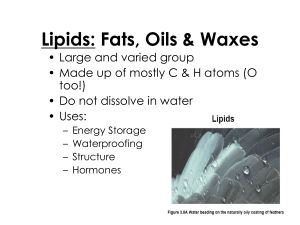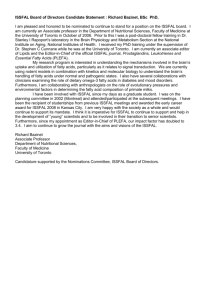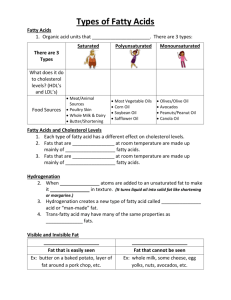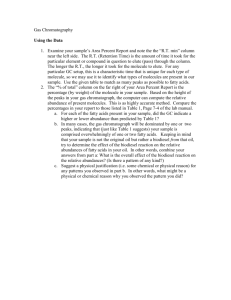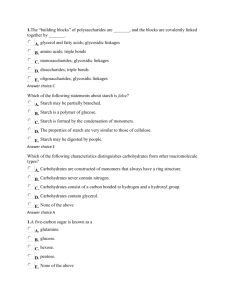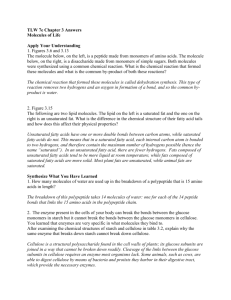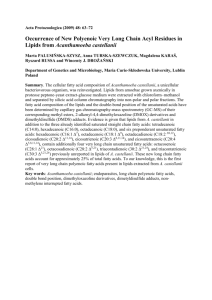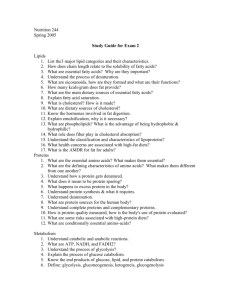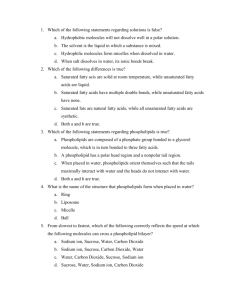Lipids
advertisement
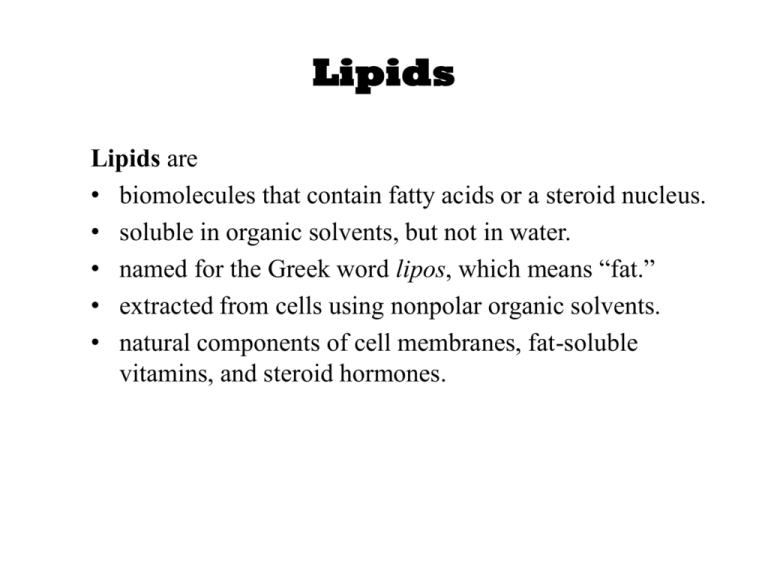
Lipids Lipids are • biomolecules that contain fatty acids or a steroid nucleus. • soluble in organic solvents, but not in water. • named for the Greek word lipos, which means ―fat.‖ • extracted from cells using nonpolar organic solvents. • natural components of cell membranes, fat-soluble vitamins, and steroid hormones. Lipids There are 2 types of lipids; • those that contain the structural component of a fatty acid; and • those that contain the structural component of a four member steroid molecule. Types of Lipids The lipids that contain fatty acids are • waxes, • fats and oils (triacylglycerols), • glycerophospholipids, and • prostaglandins. The types of lipids that do not contain fatty acid chains are steroids. Types of Fatty Acid Lipids Learning Check Which lipids contain the alcohol glycerol? A. steroids and waxes B. triacylglycerols and glycerophospholipids C. sphingolipids and glycerophospholipids D. glycerophospholipids and waxes Solution Which lipids contain the alcohol glycerol? A. steroids and waxes B. triacylglycerols and glycerophospholipids C. sphingolipids and glycerophospholipids D. glycerophospholipids and waxes Answer is B. Triacylglycerols and glycerophospholipids contain the alcohol glycerol. Fatty Acids Fatty acids • contain long-chain hydrocarbons with a carboxylic acid. • typically contain 12 to 18 carbon atoms. • are insoluble in water. • can be saturated or unsaturated. Fatty Acid Formulas The formulas for fatty acids are written as • condensed structural formulas. • skeletal formulas. Saturated Fatty Acids Saturated fatty acids have • only single C—C bonds. • molecules that fit closely together in a regular pattern. • have properties similar to alkanes. Saturated Fatty Acids Unsaturated Fatty Acids Unsaturated fatty acids • have one or more double bond. • that are naturally occurring have one or more cis double bond insert picture of cis and trans fatty acid from top of pg 602 Monounsaturated Fatty Acids Unsaturated fatty acids with one double bond are called monounsaturated fatty acids. Insert table 17.1 monounsaturated fatty acids. Polyunsaturated Fatty Acids Unsaturated fatty acids with more than one double bond are called polyunsaturated fatty acids. Insert table 17.1 polyunsaturated fatty acids. Properties of Saturated Fatty Acids Saturated fatty acids • fit closely together in a regular pattern. • are solids at room temperature. Properties of Unsaturated Fatty Acids Unsaturated fatty acids • have ―kinks‖ in the fatty acid chains. • do not pack closely. • are liquids at room temperature. ―kinks‖ in chain Prostaglandins Prostaglandins have • 20 carbon atoms in their fatty acid chains. • differ by the substituents attached to the 5-carbon ring. Prostaglandins and Physiological Effects Prostaglandins have potent physiological effects. • Some increase blood pressure. • Some lower blood pressure. • Some stimulate contractions and relaxation of smooth muscle in the uterus during the birth process and menstrual cycle. When tissues are injured, arachidonic acid in the blood is converted to PGE1 and PGF2 that produce inflammation and pain in the area. NSAIDs and Prostaglandins Several nonsteroidal anti-inflammatory drugs (NSAIDs), such as aspirin, block production of prostaglandins decreasing pain, inflammation, and fever. Insert Picture of arachidonic acid conversion, top page 605. NSAIDs and Prostaglandins Other NSAIDs include naproxen (Aleve and Naprosyn), ketoprofen (Actron), and nabumetone (Relafen). Long-term use of such products can result in liver, kidney, and gastrointestinal damage. Omega-3 and Omega-6 Fatty Acids Fish and vegetable oils have high levels of unsaturated fats. In vegetable oils, they are mostly omega-6 with the first at C6. Linoleic acid In fish oils, they are mostly omega-3 with the first at C3. CH3─CH2─(CH═CH─CH2)3─(CH2)6─COOH 1 3 Linolenic acid Omega-6 and Omega-3 Fatty Acids Omega-3 Fatty Acids Omega-3 fatty acids • lower the tendency of blood platelets to stick together, thereby reducing the possibility of blood clots. • can help reduce risk of heart disease. • are found in salmon, tuna, and herring. Learning Check Draw the condensed structural formulas for each of the fatty acids with 10 carbon atoms that follow. A. saturated Learning Check Draw the condensed structural formulas for each of the fatty acids with 10 carbon atoms that follow. B. monounsaturated omega-3 Learning Check Draw the condensed structural formulas for each of the fatty acids with 10 carbon atoms that follow. C. monounsaturated omega-6 Solution Draw the condensed structural formulas for each of the fatty acids with 10 carbon atoms that follow. A. saturated CH3—CH2—CH2—CH2—CH2—CH2—CH2—CH2—CH2—COOH B. monounsaturated omega-3 C. monounsaturated omega-6 Waxes Waxes are • esters of saturated fatty acids and long-chain alcohols each containing 14 to 30 carbon atoms. • coatings that prevent loss of water from leaves of plants. Typical Waxes Fats and Oils: Triacylglycerols Fats and oils are • also called triacylglycerols. • triesters of glycerol. • produced by esterification. • formed when the hydroxyl groups of glycerol react with the carboxyl groups of fatty acids. • a major form of energy storage for animals. Insert picture of polar bear pg 608 Triacylglycerols In a triacylglycerol, glycerol forms ester bonds with three fatty acids. Insert structure top pg 608 as shown: Formation of a Triacylglycerol • Most naturally occurring fats and oils are mixed triacylglycerols that contain glycerol bonded by ester bonds to two or three different fatty acids, typically palmitic acid, linoleic acid, and stearic acid. • One possible structure follows. Learning Check Draw the condensed structural formula for glyceryl tripalmitoleate (tripalmitolein). Solution Draw the condensed structural formula for glyceryl tripalmitoleate (tripalmitolein). Fats and Oils • Fats and oils are one of the three energy sources provided by diet. • Nutritionists recommend that less than 30% of the daily dietary caloric intake by derived by fats. • Fats provide more energy per gram than carbohydrates and protein • When calculating calories from fat, multiply by 9, for carbs and protein multiple by 4. Properties of Fats and Oils A triacylglycerol that is usually called a fat • is solid at room temperature. • is prevalent in meats, whole milk, butter, and cheese. A triacylglycerol that is usually called an oil • is liquid at room temperature. • is prevalent in plants, such as olive and safflower. Oils with Unsaturated Fatty Acids Oils • have more unsaturated fats. • have cis double bonds that cause ―kinks‖ in the fatty acid chains. • cannot pack triacylglycerol molecules as closely together as in fats. • are liquids at room temperature. Triacylglycerol with Unsaturated Fatty Acids Unsaturated fatty acid chains have kinks that do not allow close packing, such as those in olive oil. Saturated and Unsaturated Fatty Acids In Fats and Oils Vegetable oils are liquids at room temperature because they have a higher percentage of unsaturated fatty acids than do animal fats. Chemical Properties of Triacylglycerols The chemical reactions of triacylglycerols are similar to those of alkenes and esters. • In hydrogenation, double bonds in unsaturated fatty acids react with H2 in the presence of a Ni or Pt catalyst. • In hydrolysis, ester bonds are split by water in the presence of an acid, a base, or an enzyme. Hydrogenation of Glyceryl Trioleate In a hydrogenation reaction, H2 adds across the double bond to form a carbon–carbon single bond. Hydrogenation of Oils The hydrogenation of oils • converts double bonds to single bonds, • adds hydrogen (H2) to the carbon atoms of double bonds, • produces solids, such as margarine and shortening Cis and Trans Fatty Acids Unsaturated fatty acids can be • cis with bulky groups on the same side of • trans with bulky groups on opposite sides of , or . Trans Fatty Acids and Hydrogenation Trans fatty acids • are formed during hydrogenation when cis double bonds are converted to an undesirable side product with a trans double bond. • in the body behave like saturated fatty acids. • are estimated to make up 2–4% of our total calories. The American Heart Association recommends the use of soft margarine, which is only slightly hydrogenated and therefore has fewer trans fatty acids. Trans Fats In vegetable oils, • the unsaturated fats usually contain cis double bonds. • during hydrogenation, some cis double bonds are converted to trans double bonds (more stable), causing a change in the fatty acid structure. Formation of Trans Fats Learning Check Identify each statement as true (T) or false (F). A. There are more unsaturated fats in vegetable oils. B. Hydrogenation of oils converts some cis-double bonds to trans-double bonds. C. Animal fats have more saturated fats. Solution Identify each statement as true (T) or false (F). T A. There are more unsaturated fats in vegetable oils. T B. Hydrogenation of oils converts some cis-double bonds to trans-double bonds. T C. Animal fats have more saturated fats.
